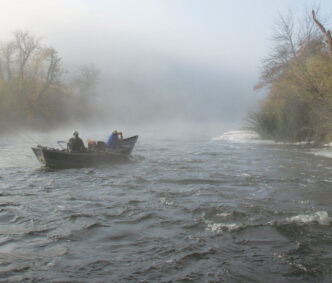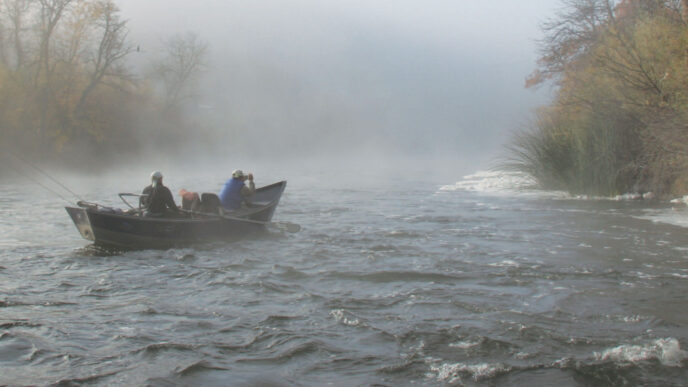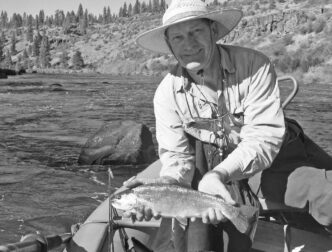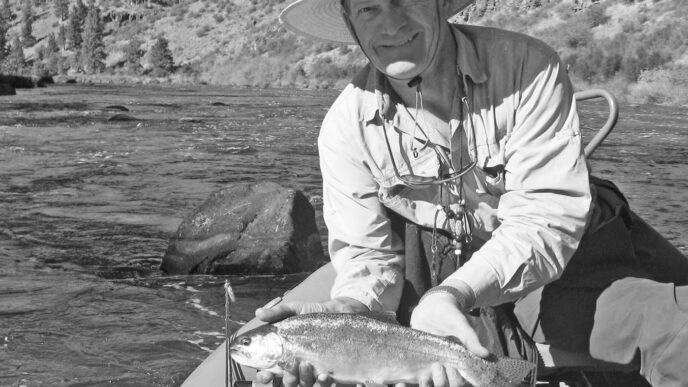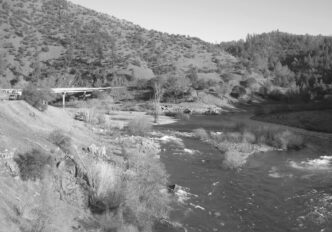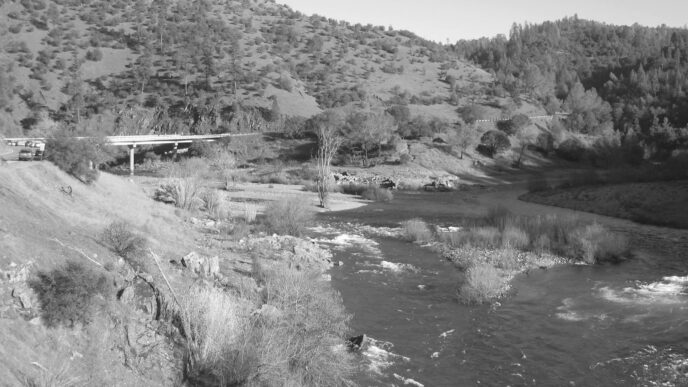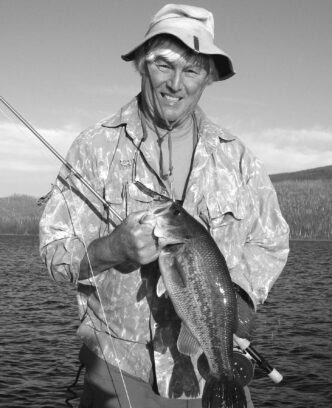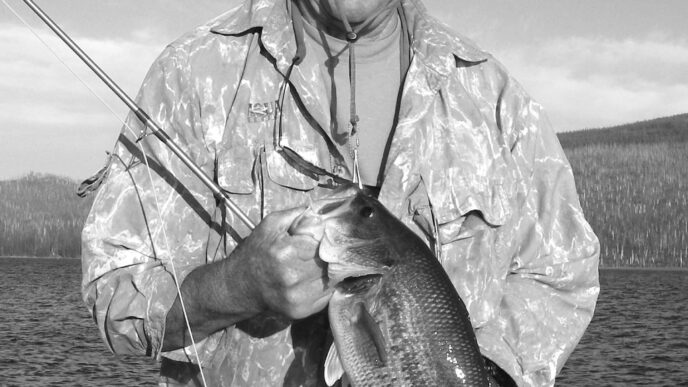Fishing, particularly trout fishing, is a reflective pastime best experienced and enjoyed when alone. For this reason, the sport tends to attract more than its share of misanthropes, a group to which I shamelessly belong. For me – and for a number of my compatriots – to see even one other angler on a stream is to see one too many, and our day may be ruined irretrievably if, during the course of escape, we come across a group of, say,, two, flogging the water in front of us.
Unless, of course, these other guys are my buddies, and they’re fishing worse than I, and they’ve brought along a decent supply of beer and potato chips.
Which is rarely the case, on all counts.
Unfortunately, solitude for the angler is becoming increasingly difficult to find, especially in California. This is no surprise, really, when you consider the intertwined impact of two demographic factors: first, that people keep moving to this state despite the high cost of everything except sunshine; and second, that fishing – in particular, fly fishing – is becoming an increasingly popular form of outdoor recreation. But even I have to admit (albeit grudgingly) that this popularity is not a bad thing because it also translates to political support for wise environmental management policies.
Crowding will continue, especially on well known and easily accessible trout streams. One of the best solutions for escaping the press of too much flesh is nothing more difficult than to take a hike. And, lucky for us, there are few better places to go than up into the wilds of our very own Sierra Nevada, John Muir’s ‘Range of Light,’ only a few hours of fast driving from the state’s metropolitan areas.
The Sierra is dotted with hundreds of trout – rainbows, German browns, brookies, cutthroats (Lahontan and Paiute), and those most beautiful of California’s native salmonids, golden trout, which are generally found only above the 8,000-foot elevation.
Locating these various fish requires a little bit of pre-trip research, some strenuous walking, and a whole lot of experimentation with rod and reel. Particularly given that a number of the lakes and streams in the mountains are either devoid of trout or may at some point become so (yes, acid rain and snow are having a measurable effect on California’s alpine waters). This uncertainty gives the search the aspect of a crapshoot – which isn’t necessarily a bad thing, as it can entice further exploration. To improve the odds, though, there are several resources available which can help you find good sport and isolation.
The first resource is Wilderness Press in Berkeley, which publishes a number of paperback guidebooks on trails in the Sierra Nevada. For a long time I ignored these books, figuring that because they were targeted for backpackers (most of whom, from my experience, prefer to march rather than fish) they would contain zilch about trout. A mistake for sure; when I finally picked one up and browsed through it, I found that the authors had made a surprisingly sincere effort at detailing the angling available near the trails they described.
To start your planning, two excellent volumes from the Wilderness Press line are Sierra North and Sierra South, which compile backcountry trips for the entire Sierra Nevada region. From the quality of the information provided, I would bet any number of trout flies that the authors spent as much time fishing as they did hiking (although this doesn’t necessarily seem to be the case with some of the other writers in the Wilderness Press series).

Wilderness Press books can be found in most stores that specialize in backpacking gear, as well as in local bookstores. You can also purchase their publications by mail; a catalog with order form is available from Wilderness Press, 2440 Bancroft Way. Berkeley. CA 94704.
The second useful resource for figuring out where to hike and fish is the Sierra Trout Guide, by Ralph Cutter (published by Frank Amato Publications, in Portland). Cutter’s book describes in some detail the various species of trout found in the Sierra, the bugs they eat, and the environmental and fishery management problems that the region now faces – all of which is good background for any foot-loose angler. Of most utility, though, are 11 pages of tables that list, by county and USGS topographic map, Sierra lakes and streams that are known to have recently contained trout. This is great stuff for anyone who wants to do some bushwhacking away from the trails described by the Wilderness Press folks.
And speaking of bushwhacking – or of any hiking, for that matter – you’ll need a good map to keep from getting lost and to pinpoint the waters you plan to fish. You can either use USGS topo maps, which are drawn to a scale of an inch to the mile or use the topo maps published by Wilderness Press, which are updated and tear-resistant versions of USGS maps, although less comprehensive in terms of area covered. As with the books noted above, both types of maps can usually be found in stores that specialize in backpacking gear. The USGS maps can also be purchased from the U.S. Geological Survey, Federal Center, Denver, CO 80225. If buying through the mail, you should first order the state index map, which is free.
Also helpful are the maps of national forests that are published by the U.S. Forest Service. These maps are scaled at 3/8ths of an inch to the mile, and because they do not show contour lines, they are virtually useless for finding your way around in the woods. What they do show, though, are Forest Service roads (usually unpaved), private lands, and many potentially fish able waters. Forest Service base maps can be bought for a small fee at ranger stations, and from U.S. Forest Service, 630 Sansome Street, San Francisco, 94111. Their index map is free.
For the most part, Sierra trout are opportunistic feeders; they’ll pretty much hit anything that looks buggy. You’ll rarely have to match the hatch to catch a batch. When fishing creeks, all you really need are a handful of generic dry flies – Adams’, humpies, Royal Wulffs, Light Cahill’s – in size 14, say, and a nine-foot leader with 4x tippet.
Lakes and slow-water streams. however, often require more precise imitations and delicate leaders, and on big rivers such as the Truckee weighted nymphs typically provide the greatest chance for success. But these latter waters are where you’ll also find the majority of other anglers; for me, at least, the epitome of Sierra angling – of getting away from it all – is creek fishing. The trout might not be large, but they’re spirited fighters, and, as a decided plus, their surroundings are almost always stunningly beautiful.
Incidentally, if you’re catching creek-bred Eastern brook trout, don’t feel guilty about banking a few and saving them for the frying pan; these prolific critters often overpopulate their streams, leading to stunted fish and the displacement of other trout.
(Note: current fishing regulations applied in the Sierra District allow a daily harvest of 10 brook trout less than eight inches in length. The two Sierra waters excluded from this blanket regulation are Red Lake in Alpine County and Kirman Lake in Mono County.)
The best angling frequently occurs near dusk, when insect activity intensifies and the trout become less cautious, feeding at the surface of streams and lakes.

However, this means that unless you want to hike out in the dark – which is, in a word, stupid – you’ll have to camp overnight. If properly prepared, camping is a lot of fun, especially in the Sierra, and especially if the night sky is clear. Looking at an infinity of stars is a great way to get perspective on things.
Plenty of books are available concerning the how-to’s of camping (and of backpacking and angling), the exploration of which is beyond the scope of this article. If you don’t already have gear, I recommend going to a store that specializes in backpacking and mountaineering equipment. Tents, boots, packs and stoves have evolved tremendously over the last couple of decades, and it helps to get the best advice possible when purchasing these things.
If you intend to backpack with your flyrod, make sure to carry it in its protective case – do not assume that simply burying it unsheathed in your pack or sleeping bag will keep it from breaking. But because carrying a four-foot tube is awkward, especially when in the trees, you might also want to consider investing in a multi-piece travel rod that fits within a pack. Fly rod technology has advanced to the point where the multi-piece rods made by top manufacturers cast every bit as two piecers.
Although waders and felt-soled boots are useful for big water, they’re unnecessary for most creeks. You can get by with hip boots, and when the weather’s warm (and the snowmelt is gone from the streams), I prefer to wade in shorts and tennis shoes – a tack which is guaranteed to lead to scrapes and bruises, but heck, in a way these are badges of honor. Unfortunately, I’ve been unable to find felt-soled tennies that are light enough to include as part of a pack load, and my attempts at gluing felts to rubber soles have so far been a tremendous failure, with the felts flopping off after only a day or so of wading. (if you have ideas on where to buy or how to make felt-soled shoes for backpacking anglers, please drop me a line care of California Fly Fishers).
Finally, here are a few nuggets of hard-earned wisdom that may heighten your enjoyment of the mountains: (a) if you’re a novice backpacker, start out with short, easy overnight trips rather than 50-mile blister busters, and do not let your “friends” convince you other wise; (b) buy a lightweight backpack stove and learn how to use it before you leave; (c) cigar smoke is an ineffective mosquito repellant, although with enough brandy you may not care; (d) in bear country, do not eat cookies in your sleeping bag; and (c) losing machismo is better than losing toes, so do not be reluctant to head for home if the weather turns for the worse.
Three Sierra Waters Worth Visiting
Although a number of the small streams and creeks in the Sierra cannot support a large amount of angling pressure, some waters are either threatened with destruction or are overpopulated with stunted trout, and could use additional friends. If you want solitude and great fishing (albeit for dinky trout), but don’t know where to start, you might want to try one or more of the following three streams:
The Clavey River. The Clavey was among the first of California’s official “wild trout” waters, having received that designation from the Department of Fish and Game about 20 years ago. It is also a wonderful stream that may soon be inundated by a hydropower dam – a dam that, for all intents and purposes, is absolutely unnecessary. Unfortunately, one of the reasons why the structure may be built is because few anglers have stepped forward in support of the Clavey’s trout fishery. Shame on us (and hey, get involved).
Although the Clavey can be reached by roads that run south out of Twain Harte and Tuolumne, the part of the river that I’m most familiar with is reached via Forest Service Road 3N01 that runs south out of the town of Long Barn, on Highway 108. The Clavey here is anything but large and tends to fall to a trickle by autumn, but the trout are plentiful, wild, and love to hit dry flies (make sure, though, that you visit after spring runoff; during high water, the trout are hard to find, even with nymphs).
There are places along the Clavey that are suitable for car camping; explore the side roads that branch out from the main access road. You’ll come across other folks doing the same thing – the river is only three hours or so from the Bay Area – but when you fish you can usually escape these people by hiking a short distance up or down the canyon. And remember, if this fishery is lost, it’s because we didn’t fight hard enough to save it.
Big Creek. Big Creek is misnamed – you can almost jump across it in places but, the stream contains an extra ordinary number of rainbows and brookies that will hit your fly throughout the day. Which is an important consideration because you’ll need to allocate a couple of hours to hike into the watershed behind Huntington Lake (on Highway 168, east of Fresno), where fishing pressure is lightest. A good place to start your hike is the Badger Flat campground, where a trail head is located. A mountain bike might be useful and fun here, by the way.
Shadow Creek. When I fished this stream last year it was filled with ‘snakes’ – you know, trout that have big heads and slender bodies, a sign of too many fish relative to the food available. Which was astounding because the creek ran along a very heavily-used trail – clearly, no one was stopping to harvest a few trout! And clearly, here you should bonk a few for the frying pan (especially the brookies); this reduction of competition would help the survivors grow a bit larger.
The section of Shadow Creek that I fished is between Shadow Lake and Lake Ediza, at the base of the spectacular Ritter Range. In fact, the scenery itself is the reason for making this two day backpack trip; the fishing, while fun, is strictly secondary to the drama of the mountains.
The trailhead for Lake Ediza is at Agnew Meadows Campground in the Devils Postpile National Monument. Be warned, though: this trail is popular, and as a result, you’re sure to encounter many other hikers and, at night, bears in your camp.
– Richard Anderson





